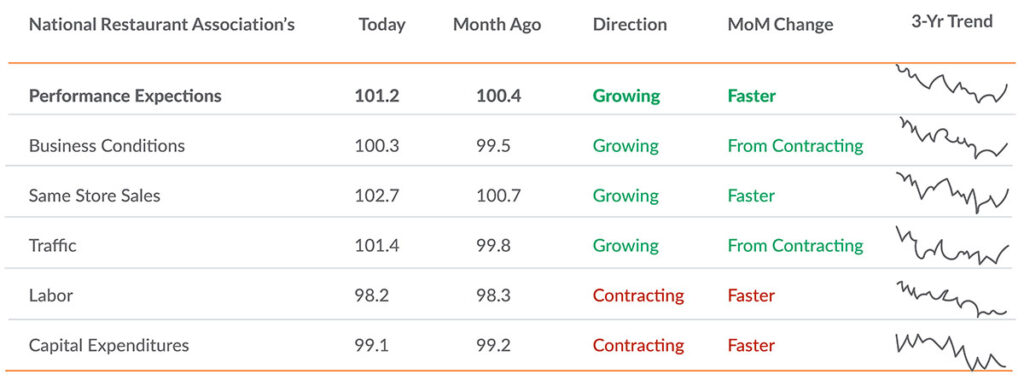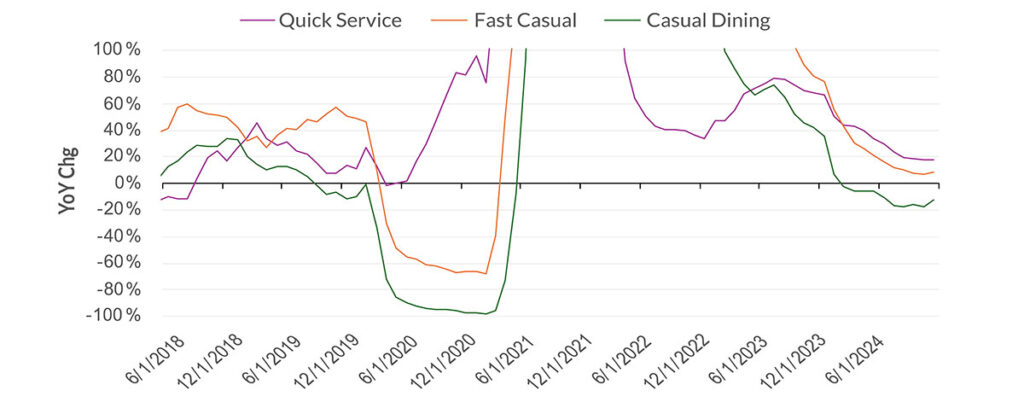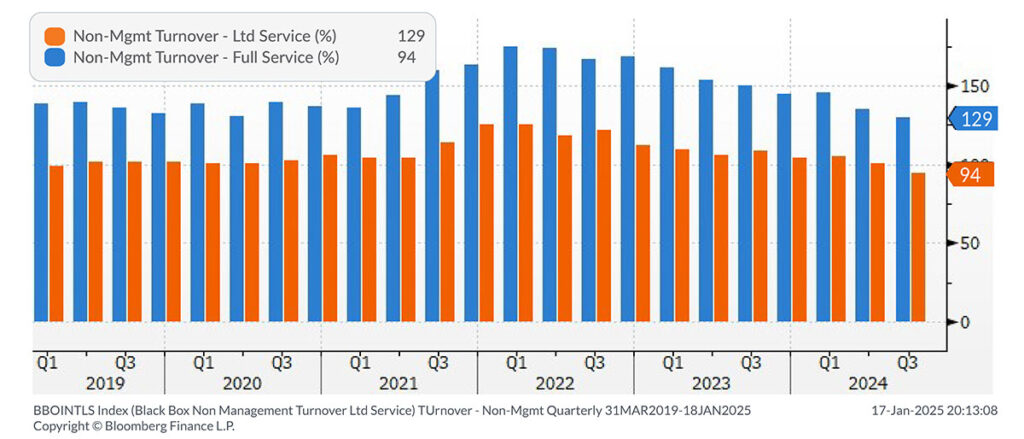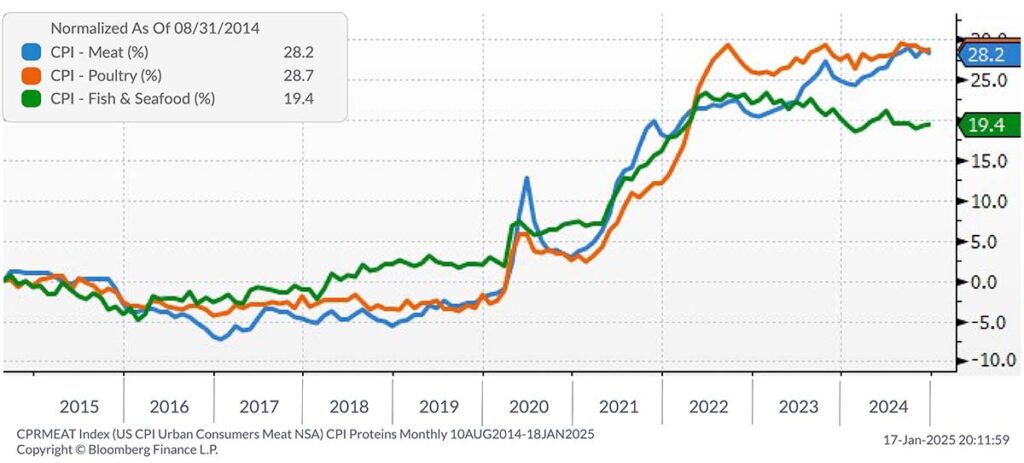6 Key Restaurant Industry Insights and What They Mean for Your Business
February 10, 2025
2025 First Quarter Report
What we are seeing in restaurants
Restaurant operators are navigating mixed signals as performance metrics show signs of optimism and caution. On one hand, key metrics such as same-store sales and traffic are growing at a faster rate. However, persistent challenges like high turnover rates, rising costs, and pressures on consumer spending continue to strain margins. Operators need to remain vigilant in monitoring KPIs to adjust in this environment.
Here are six key takeaways to keep in mind as we kick off the new year:
1. Metrics Show Mixed Progress

Performance expectations from the National Restaurant Association show growth, with the overall index increasing to 101.2. Business conditions, same-store sales, and traffic metrics are all growing at a faster pace. Yet, labor and capital expenditures are still facing headwinds.
What this means for you: The growth in key performance metrics provides a glimmer of optimism for the industry. Operators should capitalize on this momentum by focusing on enhancing customer experiences and refining operational efficiencies. At the same time, the contraction in labor and capital expenditures underscores the need to invest wisely in workforce management and technology to enhance productivity.
2. Same Store Sales Increasing on Transaction Growth

Transaction growth has surpassed dollar volume growth, but average ticket size is declining. This trend signals that while more customers are dining out, they’re spending less per visit, underscoring the growing importance of value-driven decisions.
What this means for you: Restaurants should examine pricing strategies and menu offerings to balance traffic growth with profitability. Promotional campaigns or value-driven menu options could help sustain transaction volumes while addressing consumer sensitivity to price increases.
3. Diverging Year-Over-Year Sales Trends: Growth in Quick Service, Declines in Casual Dining

Quick service and fast casual segments are stabilizing after a period of significant post-pandemic volatility, but casual dining is experiencing ongoing year-over-year declines. These diverging trends highlight shifting consumer preferences, with quick service and fast casual maintaining steady demand, while casual dining faces greater headwinds.
What this means for you: Operators in quick service and fast casual segments should capitalize on this stability by reinforcing customer loyalty through digital ordering enhancements and tailored promotions. Casual dining operators, however, must address declining sales by focusing on creating differentiated experiences, adjusting pricing strategies, and re-engaging customers through targeted marketing initiatives. Adapting to these trends is critical to sustain growth and mitigate challenges.
4. Cost of Dining Out Continues to Outpace the Cost of Eating In

Since 2019, the cost of food away from home has risen 30%, compared to a 27.6% increase in the cost of food at home. This widening gap could influence consumer decisions and impact restaurant traffic.
What this means for you: To maintain margins, operators need to carefully manage menu pricing while emphasizing the value of dining out. Highlighting unique experiences, convenience, or premium ingredients can help justify price differences and keep customers engaged.
5. Employee Turnover Has Come Down but Remains High

Non-management turnover rates remain elevated, with limited-service restaurants experiencing a 129% annual turnover rate, while full-service restaurants are at 94%. While these figures have slightly improved from recent peaks, they continue to challenge operators.
What this means for you: Addressing high turnover rates should remain a top priority. Investment in employee engagement, management training programs, and competitive benefits can help reduce turnover and improve operational efficiency. Fostering a strong workplace culture can be key to reducing employee churn.
6. Protein Costs Remain Elevated

Protein costs continue to pressure the bottom line, with poultry, meat, and seafood seeing inflation rates of 28.7%, 28.2%, and 19.4%, respectively, compared to pre-pandemic levels. These sustained price increases make it increasingly difficult for operators to maintain profitability without adjusting pricing or operational strategies.
What this means for you: Focus on rethinking your menu strategy by introducing more cost-effective protein options, including varying portion sizes while maintaining customer satisfaction. Explore alternative suppliers or renegotiate contracts to reduce input costs and communicate any menu adjustments transparently to retain customer trust. Additionally, consider diversifying your offerings to include high-margin, plant-based, or seasonal dishes to balance rising protein costs.
Disclosures
Investment advisory services are offered by Aprio Wealth Management, LLC, a Securities and Exchange Commission Registered Investment Advisor. Opinions expressed are as of the publication date and subject to change without notice. Aprio Wealth Management, LLC shall not be responsible for any trading decisions, damages, or other losses resulting from, or related to, the information, data, analyses or opinions contained herein or their use, which do not constitute investment advice, are provided as of the date written, are provided solely for informational purposes and therefore are not an offer to buy or sell a security. This commentary is for informational purposes only and has not been tailored to suit any individual. References to specific securities or investment options should not be considered an offer to purchase or sell that specific investment.
This commentary contains certain forward-looking statements. Forward-looking statements involve known and unknown risks, uncertainties and other factors which may cause the actual results to differ materially and/or substantially from any future results, performance or achievements expressed or implied by those projected in the forward-looking statements for any reason. No graph, chart, or formula in this presentation can be used in and of itself to determine which securities to buy or sell, when to buy or sell securities, whether to invest using this investment strategy, or whether to engage Aprio Wealth Management, LLC’s investment advisory services.
Investments in securities are subject to investment risk, including possible loss of principal. Prices of securities may fluctuate from time to time and may even become valueless. Any securities mentioned in this commentary are not FDIC-insured, may lose value, and are not guaranteed by a bank or other financial institution. Before making any investment decision, investors should read and consider all the relevant investment product information. Investors should seriously consider if the investment is suitable for them by referencing their own financial position, investment objectives, and risk profile before making any investment decision. There can be no assurance that any financial strategy will be successful.
Certain investor qualifications may apply. Definitions for Qualified Purchaser, Qualified Client and Accredited Investor can be found from multiple sources online or in the SEC’s glossary found here https://www.sec.gov/education/glossary/jargon-z#Q.
Recent Articles
About the Author
Simeon Wallis
Simeon Wallis, CFA, is a Partner, the Chief Investment Officer of Aprio Wealth Management, and the Director of Aprio Family Office. Each month, Simeon brings you insights from the financial markets in Aprio’s Pulse on the Economy. To discuss these ideas and how they may affect your current investment strategy, schedule a consultation.
Tommy Lee
Tommy Lee, CPA, is the Partner-in-Charge of Aprio’s Restaurant, Franchise, and Hospitality practice. Tommy serves as a strategic tax and business advisor to the executives and owners of middle-market restaurant, franchise, and hospitality operations across the nation. Schedule a consultation with Tommy if you are searching for industry-specific tax and advisory expertise.
Mark Kashgegian
Mark Kashgegian, CPA, Restaurant, Franchise, and Hospitality – Partner, has more than 40 years of experience providing restaurant accounting, strategic business planning, transitional and family planning to restaurant franchises, multi-unit franchisees, and restaurant groups based across the U.S. Schedule a consultation with Mark if you are searching for industry-specific tax and advisory expertise.
Stay informed with Aprio.
Get industry news and leading insights delivered straight to your inbox.



